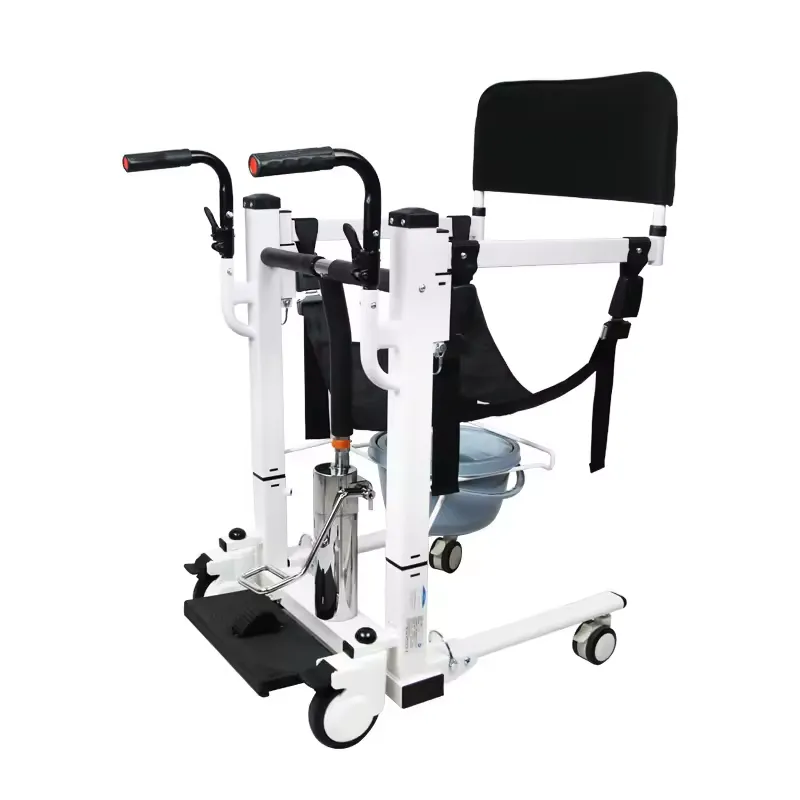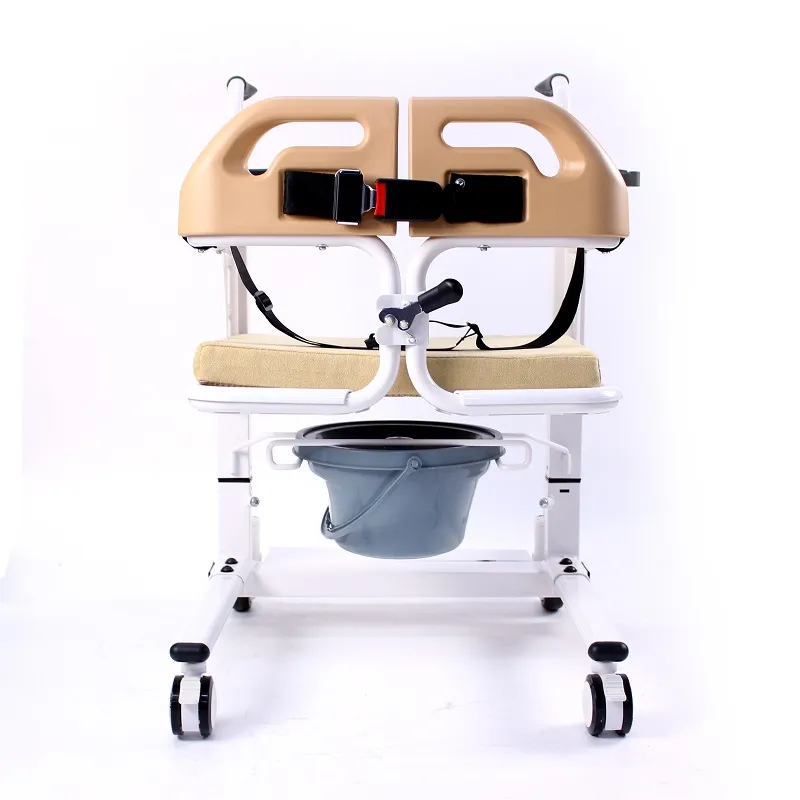As a mobility and transfer tool designed specifically for individuals with limited mobility, the "patient lift transfer chair" can effectively reduce labor burden, improve transfer efficiency, and enhance patients' quality of life.
However, there are also common misconceptions and taboos in the actual use of this type of equipment. Ignoring the proper procedures for using a "patient lift transfer chair" not only compromises operational efficiency but can also cause irreversible harm to patients.
This article systematically addresses the core question of "What should you avoid when using a transfer chair?" and comprehensively analyzes the actions operators should absolutely avoid during each stage of using a patient lift transfer chair, including preparation, movement, locking, and upper and lower transfers.
Clarifying the purpose and structure of the "patient lift transfer chair"
The "patient lift transfer chair" is a multifunctional mobility device designed specifically for bedridden patients, elderly individuals with limited mobility, and patients recovering from surgery. It incorporates a lifting mechanism, a brake and locking system, a detachable seat, armrest support, and load-bearing casters to facilitate safe transfers between beds, toilets, wheelchairs, sofas, and chairs.
Its core advantages include:
· Height Adjustment: The chair can be adjusted to different levels manually or electrically;
· Stable Structure: Typically constructed of steel or aircraft aluminum alloy, ensuring stable load-bearing capacity;
· Convenient Mobility: Equipped with large-diameter wheels and a universal wheel lock system for smooth movement;
· Protective Design: Features include safety belts, leg restraints, and guardrails to prevent slipping.
However, due to its complex integration of functions, operators without the necessary expertise and proficiency can make mistakes during patient transfers, potentially posing a safety hazard.

What should you avoid when using a transfer chair for patient transfers?
Nine things you absolutely shouldn't do when transferring a patient:
1. Using the device without inspecting it
2. Not locking the brakes or moving the device during transfer
3. Lifting the patient before the patient is stabilized
4. Carrying a load exceeding the specified weight limit
5. Not using the safety belt or locking the siderails
6. Performing complex transfers alone
7. Transferring a patient on a slope or slippery surface
8. Sudden stops or repeated switching of the lift direction during operation
9. Using the device as a "long-term seat" or a standard wheelchair
1. Using the device without inspecting it
Before using a patient lift transfer chair, the operator must conduct a complete inspection, including:
· Whether the lift mechanism is operating properly;
· Whether the four casters are stable and unlocked;
· Whether the brakes lock promptly;
· Whether the seat and backrest are securely fastened;
· Whether the safety belts and siderails are intact.
❌ Mistake: Using an uninspected transfer chair, especially when the wheels are unlocked, can easily cause the chair to tip over and fall.
2. Not locking the brakes and moving the device during transfer
A key safety feature of the patient lift transfer chair is the wheel brake lock. The brakes must be engaged to lock all four casters during vertical, lateral, or positional adjustments.
❌ Mistake: Disengaging the brakes and pushing the chair before the patient is fully stabilized or while the patient is being moved can easily cause the device to slip and the patient to fall.
3. Lifting the chair before the patient is stabilized
The vertical lift function of the lift transfer chair is a key technical feature. However, before using this function, the patient must ensure that both feet are firmly on the footrests, the patient is holding the armrests, the patient's back is firmly against the backrest, and the safety belt is fastened.
❌ Mistake: Activating the lift without checking the patient's position for stability can cause the patient's center of gravity to shift, the patient to tilt, resulting in lumbar spine injury, or the patient may fall from the chair.
4. Exceeding the specified weight limit
Patient lift transfer chairs are typically marked with a maximum weight capacity of 100 to 150 kg, depending on the model and material. During use, the patient's weight must be strictly controlled within the equipment's weight capacity.
❌ Mistake: Forcing an overweight patient onto a lightweight lift transfer chair can not only damage the equipment but also cause structural collapse during lifting, sliding, or securing, potentially leading to serious injury.
5. Not using a safety belt or locking side rails
All properly designed patient lift transfer chairs are equipped with a safety belt and side rails to prevent patients from slipping or tipping over during transfer due to jolts, convulsions, fatigue, and other factors.
❌ Mistake: Omitting the safety belt and locking side rails due to time constraints or improper operation can cause the patient to become unstable on the chair and increase the risk of falls.

6. Single-person operation of complex transfers
Although the patient lift transfer chair is designed for convenience, it is still recommended that two people work together for challenging transfers (such as transferring from a bed to or from a toilet).
❌ Mistake: Performing high-intensity transfers alone can easily lead to transfer failures or even falls due to sudden movements by the patient (such as twitching or struggling).
7. Transferring patients on slopes or slippery surfaces
Although the casters on a patient lift transfer chair have a certain degree of anti-slip properties, they should still be used primarily on dry, flat, and firm surfaces. Slopes or slippery surfaces significantly increase the risk of slipping, loss of control, and tipping.
❌ Mistake: Performing transfers in unstable areas such as bathrooms, slopes, and elevator entrances can cause the wheels to slip, leading to patient imbalance and even tipping.
8. Sudden stops or repeated switching of lift directions during operation
The electric and hydraulic systems in lift transfer chairs require a stable operating cycle. Frequent switching of operating commands (such as raise-lower-raise again) can increase system wear and even cause failure.
❌ Mistake: Repeatedly raising and lowering the chair rapidly to accommodate the patient's position, switching directions before the system resets, increasing the risk of mechanical failure, or even raising the chair before the patient is firmly seated.
9. Using as a "long-term sitting chair" or a standard wheelchair
The primary function of a "patient lift transfer chair" is to facilitate quick transfers and relocations. It is not designed as an all-weather, extended-term sitting chair or a wheelchair for long-distance transportation. Its seat cushion ventilation, comfort, and ergonomic support are far inferior to those of a standard wheelchair.
❌ Mistake: Using a lift transfer chair as a wheelchair for extended periods can easily lead to complications such as pressure ulcers on the buttocks, impaired blood circulation in the lower limbs, and back muscle fatigue.

Key Operating Procedures for Ensuring Safe Use of Transfer Chairs
In addition to clarifying "What not to do when using a transfer chair?", operators should also memorize the following standard procedures to maximize safety:
1. Pre-Transfer Preparation: Check the device's structural integrity, floor conditions, and patient condition;
2. Pre-Transfer Positioning: Lock the casters, open the side rails, and adjust the seat height;
3. Assisting with Seating: Two people should operate, holding key areas (underarms and shoulders);
4. Secure the safety belt: Tighten it to a moderate tension, avoiding compression of the chest and abdomen;
5. Stable Lifting Operation: Adjust the height slowly and smoothly to avoid sudden changes;
6. Locking the chair after transfer: Recheck the wheel brakes and seat balance;
7. After transfer: Assist the patient to stand or transfer to the target carrier;
8. Equipment Disinfection and Maintenance: Wipe metal parts and inspect the mechanical structure.
What makes your electric wheelchairs stand out?
Our electric wheelchairs, produced in our Foshan facility since 2009, integrate robust OEM design, reliable motors, advanced batteries, and user-centric controls. They are certified by FDA, CE, and TUV, ensuring high safety and performance.
With two strategic R&D centers, we offer custom models, bulk orders, cheap pricing, and attractive wholesale packages. Whether sourcing from a high-quality Chinese supplier, you get CE - marked, ISO - controlled equipment at factory - direct rates, with promotional offers and partnership-friendly quotes.










